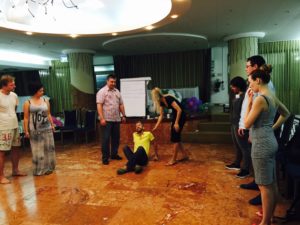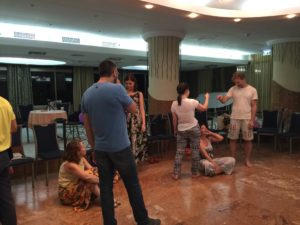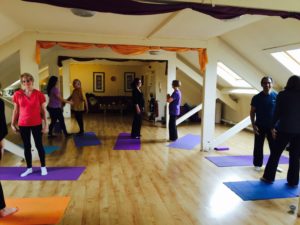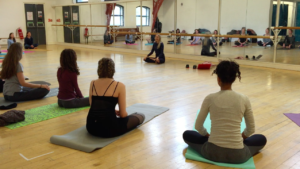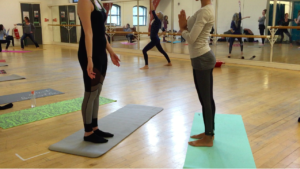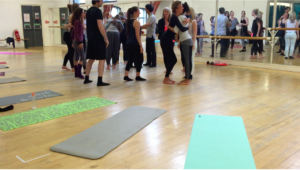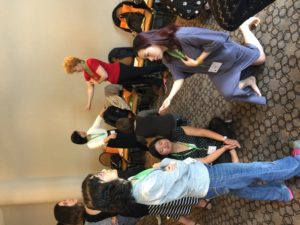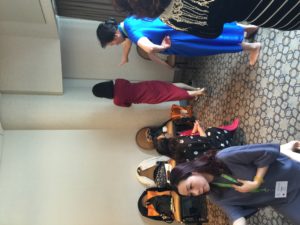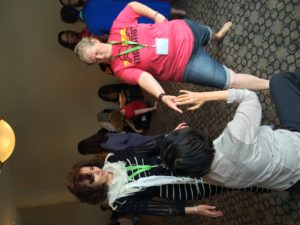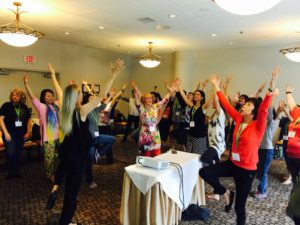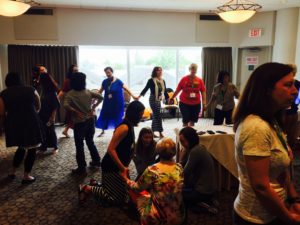STASIS-KINESIS: INTEGRATIVE MOVEMENT THERAPY
In the world of stress and fast-pace communication there is a longing for tranquility and peace.
STASIS-KINESIS beautifully combines movement, stillness and rhythm to create an opportunity to release fear, relax from stress and move into more congruent behaviours and fruitful states such as joy, happiness, lightness, peace, confidence, strength and serenity.
The practice stems from Siberian dance, dynamic yoga and systemic family therapy[1]. It is an easy to practice method of self-expression that helps create a healthy dialogue between mind and body.
Highly beneficial for people who…
- lack movement in every-day life
- have low self-esteem
- are in need of self-expression
- suffer mood-swings
- go through a stressful period
- feel stuck in their life
- want to have more joy and happiness
- want to feel light and free
- seek confidence and inner-strength
- look for bliss and serenity
- want to raise self-esteem
Principles & Theoretical Underpinnings:
- Movement has two directions: contracting and expanding. With STASIS-KINESIS we move towards the latter.
- Changing physiology we can change neurology.
- Non-verbal communication is involuntary.
- Phenomenological experience is underpinned by mirror-neurons.
- Information is stored in the body and can be transformed.
- Perception of behavioral models influences embodied experience, hence changing visual perception of relationship, changes our reality.
- Relational Map is not a Territory. Inquiry into a broader perspective is needed.
- Space & Time are mental constructs. By being ’here & now’ we increase chances of ‘healing’ the past and making effective choices in future.
- Projected visualization of past-experienced relationship models opens a possibility to look at them from a distance. This process raises awareness of what is, and is healing on its own.
- Dancing from incongruent stance towards a better stance is therapeutic.
5 Stance-Dances:
- Blamer – Peaceful Warrior
Stress: A blaming stance or ‘Blamer’ is a stance when a person takes a position of blaming someone or something else, without taking responsibility for themselves. The underlying need is to be protected, safe and respected. Physically this stance would be represented by a person pointing a finger with a stretched arm leaning forward on one front leg. Front leg is one and a half shoulders’ lengths apart and slightly bent. Back hand is on a waist. The feeling in this position is not balanced and strain on the shoulders.
Flow: Peaceful Warrior is an anti-dote to the Blamer. It is a position that is driven by the need of protection and safety, similarly to ‘Blamer’, but more congruent. Physically, the stretched arm goes up above the head, with a palm open, tip of fingers facing up. Looking above, the position quickly turns to be more resourceful and peaceful albeit strong and energetic.
2. Placator – Power Tree
Stress: Placating stance or ‘Placator’ is a stance when a person takes a position of a victim and takes full responsibility onto themselves. The underlying need is for love & care as well as strength & stability. Physically this stance would be represented by a person bending one knee and putting it on the ground. Looking from down up, making a begging sign with their hands, as though asking for forgiveness. Upper body and head slightly bent on one side, palms are open facing up. A position is not comfortable and strain on one side of the body, which is bent.
Flow: Power Tree is an anti-dote to the Placator stance. It is a position that helps create balance and brings stability and strength to the body. Physically it would be represented by standing up from a placating stance and raising both straight arms above the head. Feet: shoulders’ width apart. Head: looking straight with a light smile. For an advanced position, one can bend one leg and put a foot on the inner thigh of the other leg.
3. Super-Reasonable – Humble Monk
Stress: Super-Reasonable stance or ‘Computer’ is a stance when a person hides real emotions behind logic and facts. A ‘Computer’ generally prefers to use a monologue or a critique when under stress. The underlying need is for understanding and wisdom as well as for being in peace. Physically that is represented by folded arms and one arm’s pointy finger touching a cheek, or a finger pointing towards the ceiling. The body weight is on one leg creating an unbalanced position for the body.
Flow: Humble Monk is an anti-dote to Super-Reasonable stance. The body becomes straight and palms touch on the heart’s level in a ‘Namaste’ sign. Head: facing straight with a slight smile.
4. Distractor – Core Harmonizer
Stress: Distracting stance is a position when a person doesn’t want to face a tough reality and prefers to deviates to a different topic and hides the feelings behind other agenda. A person generally brings humour or skips difficult subjects, even adds chaos, in order to create emotional stability and harmony without initiating a conflict. Physically that would be represented by a person moving arms in front of other people’s faces to distract their attention. Slightly bent on one side and looking from down up laughing.
Flow: Core Harmonizer is the anti-dote to a distracting stance. It is a stable and harmonious position that helps a person feel courage and peace with a tough reality around them. Physically arms relax, palms open up, body strengthens and finds its core (similar to a Tai Chi neutral position) with slightly bent knees and straight spine.
5. Withdrawer – World Hugger
Stress: Withdrawing stance or ‘Withdrawer’ is a stance when a person moves away from discussing a difficult situation and stops talking, ‘shuts down’ from external reality. The underlying need for this stance is trust, openness and touch, the very things a person moves away from, which is counter-intuitive. Physically this stance is represented by folded arms and turning away from the other person.
Flow: World Hugger is an anti-dote to the withdrawing stance. Instead of moving away, the ‘World Hugger’ moves in and opens the arms as though they want to hug the whole world. It is a resourceful stance of hugging is considered to be connected to a ‘hug’ hormone, oxytocin.
[1] Satir, V. et. al. (1991), The Satir Model: Family Therapy and Beyond, ISBN 0831400781, Science and Behavior Books.
STASIS-KINESIS CERTIFICATION PATH:
To be a Stasis-Kinesis practitioner entails a journey through three stages. Module 1 is the Essential stage where principles and descriptions of its parts, introduction into Somatherapy are presented, experimented and understood. Module 2 builds on the essential level and adds exercises and practices of Stance-Dance Somatherapy and Family Reconstruction in engaging and profound way. Module 3 adds a path into the depth of applications of Somatherapeutic practices extending its use in family settings as well as organisations, business and teams dynamics.
Here is a brief description of three modules to be certified as a Stasis-Kinesis practitioner.
STASIS-KINESIS MODULE 1: Essentials
– Introduction into the Stasis-Kinesis. Its origin and history.
– Somatherapy and its effects on the mind.
– Principles of movements and dynamic Stasis-Kinesis meditation.
– Experimental dynamic activity (Dance) to explore effects of Somatherapy on consciousness.
– Family Copying Stances. Incongruent and congruent body language in stress: experiential practice.
– Family Copying Stances Reconstructed. Somatic practice to create a bridge between unconscious behaviour in stress and conscious reconstructed reality, to bring the ‘family system’ in balance.
STANCE-DANCE MODULE 2: Foundation
– Journey to the Self: Stasis-Kinesis Exploration of Resourcefulness
– Reconstructing thoughts through body movements.
– Experimental dynamic activity (Dance)
– Family Expanded Copying Stances.
– Healing the Family of Origin. Looking in the Mirror of our Family Soul.
– Description and exploration of Family Stances.
– Neuro-Science and Phenomenological approach to body.
– Special cases of complicated family entanglements
STASIS-KINESIS MODULE 3: Practitioner
– Application of the Stasis-Kinesis in organisational & business settings
– Anatomy of the body
– Siberian Philosophy and its application in the Stasis-Kinesis
– Dynamic Journey to the Self under stress
– Triads and Stances of Reconstruction explained
– Special cases of complicated entanglements in families, business and organisations
– Integration of conscious and unconscious processes in Somatherapy
Praise for the STASIS-KINESIS (STANCE-DANCE):
“A very enjoyable and thought-provoking session. Thank you!” – Carol Hall, PhD, Professor Emeritus of Human Relations, Nottingham University, UK
“I learnt to feel more confident and generally better at self-control” – Claudia Nogueira, Mother of Isabela
“It is different, like nothing you’ve experienced before. You shake your body and spirit. Darya teaches you how to react in different situations and why self-develop’ – Sara Alshareef
“Extremely interesting, on both an internal dialogue and external body response. Peaceful and reassuring. Darya managed to get us, ‘tight’ English people, to overcome our reserves” – Karen O’Connor
“It felt quite bizarre to begin with but Darya makes you feel so relaxed and is so personable and welcoming, you soon become uninhibited. This is an essential state of mind to benefit from the full effects of this session” – Lisa McKeon
“Just try it! A very interesting session” – Jacqueline Standen
“I didn’t know what to expect. Great experience. Everybody can and should try it. Feel danced and relaxed.” Olaf Fetter
“I now feel stronger in dealing with different personalities in the workplace, very good learning for teamwork.” Karen
“A session for everyone…to be enjoyed for all ages. Young and old… happy/sad to improve your outlook to life…You can take what you need from the session. Your mind and body will dictate. Peace & love. ” Luisa Vicinanza-Bedi
“I found it very liberating, using the dance to free myself as well as energise my body. I found the stances of behavior most interesting and that is the area of behaviours and reactions I feel that I could work on more and get more out of to use in my personal, work and relationships” – Fiona Mason
“Really really enjoyed it. It is absolutely new experience for me. I fell new and relaxed after the session and feel more joyful inside and happy.” – Yulia Kulikova
”Wonderful! Energizing and powerful. Thank you, Darya!” – Samantha
”Open your mind to a new experience and enjoy the permission to be you” – Caroline Kalsheker
”Very enjoyable. I would definitely like to do it again” – Noor Kalsheker
IMAGES FROM A STANCE-DANCE PRACTICE

